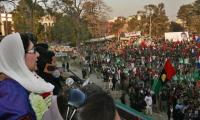A census is a quiet affair for most people in politically stable and institutionally strong countries, where the national head count runs relatively smooth and is reliably decennial. But in Pakistan, the national census is always met with suspicion, reservations, boycotts and charges of fraud.
For instance, in a housing count carried out in 2011, a precursor to the census, “a district in the north of Quetta, Qilla Abdullah, is said to have grown by more than 500 percent between 1998 and 2011 – from 370,000 residents then to over two million”.
This was confirmed by the former chief census commissioner, Habibullah Khattak, in his briefing to the National Assembly Committee on Economic Affairs and Statistics in January 2012. He also testified that a systematic over-counting of houses occurred in the Pakhtun areas in Balochistan while there was undercounting in the ethnic Baloch areas in the province.
Why is the inflation of population numbers encouraged? The answer is very simple: the flawed Pakistani federal structure is built and linked with the numbers game – the population.
Census results decide the balance of political power in a country divided over a workable framework on power-sharing and resource distribution. Provinces end up accusing each other of rigging the census for political gains.
The census results in Pakistan guide electoral delimitation, the number of seats in the National Assembly, share of revenues distributed through a controversial National Finance Commission and much-needed jobs and civil service hiring. Population strength forms 82 percent when allocating financial resources from the federation to the provinces and only 10.3 percent weight is given to poverty and backwardness.
Population as a determinant of resource distribution is not mentioned anywhere in the constitution. However, population as a criterion for the distribution of National Assembly seats is mentioned in Sub-section 5 of Article 51 of the constitution.
How did population become the super-dominant criterion to distribute wealth among the federating units? The National Finance Commission (NFC) is the one that gets to discuss and decide on ‘agreed’ formulas for resource distribution from the centre to the provinces.
Since the National Assembly is based on population, it is obvious that the province with the highest number of population will dominate the power structure and get top slots like prime-ministership and other ministries.
Practically, all commissions and institutions are dominated by the province with the highest number of population. The NFC is composed of the federal finance minister as chairperson, four provincial finance ministers, the president’s nominee appointed with consultation with the governors of the provinces.
It is obvious that in a commission of six, if a single province has three members, the outcome will always have to be favourable towards the ‘largest province’. In this way, that province would no doubt want the population criteria to be the super-dominant factor when it comes to resource distribution.
Balochistan has been raising the issue of unjust distribution of resources since the inception of the first NFC in 1974. The province has demanded that land, natural resources, strategic location, under-development and poverty should all be given equal importance when allocating resources – but to no avail.
Similarly, on the issue of jobs in the civil service, Pakistan’s constitution does not dictate that the relative population percentages of every ethnic and religious group must be used to determine the mix of those groups in all kinds of federal appointments.
Nevertheless, constitutional guarantees have been moulded through subsidiary legislation and acts of parliament, passed in a National Assembly dominated by a single province. This reframes the overall meaning of the federation.
Since the entire idea behind the census revolves around ‘population count for resources’, the results will always remain questionable, superficial and flawed.
Some also fear that census results could be tampered with. It is because of the excessive centralisation of collecting data that past censuses were deemed controversial.
According to the constitution (schedule IV, item no 9 of the Federal Legislative List Part II) the census is the CCI’s subject; the CCI is the constitutional and legal body to supervise the process of the census. Since the CCI does not have any permanent secretariat and has been kept a weak body, the census responsibility was shifted to the centre in 1974. More recently, after the 18th Amendment, the General Statistics (Re-organization) Act, 2011 transferred the control of the census to the federal government away from the CCI, contrary to what has been stipulated in the constitution.
The 18th Amendment placed huge responsibilities on the provinces and now it is the provinces that need the most to have accurate statistics about the socio-economic health and number of their residents so as to develop relevant polices and carry out effective interventions.
In addition, without the consent of the provinces, the Pakistan Bureau of Statistics (PBS) introduced a number of mandatory prerequisites to be counted in the census. These will eventually affect the people of Balochistan, Sindh and Fata.
The possession of a CNIC as a mandatory requirement to register in the census will have serious implications for Balochistan’s residents. A large number of the population will remain unaccounted for. Over 40 percent of the population in Balochistan, particularly people living in the conflict-ridden and inaccessible parts of the province, do not possess CNICs.
During the last ten years, Nadra made all possible efforts to expand its organisational presence in Punjab but didn’t focus on Balochistan, Fata and Sindh. For instance, currently Nadra has approximately over 400 offices/outlets in Punjab. In Balochistan, though, it has 34 offices to issue CNICs, with 10 of them in Quetta.
The PBS didn’t inform provinces and made no efforts to sensitise the people about the mandatory CNIC possession factor for the census. This could seem like an exclusionary tactic against the Baloch, Sindhi and Pakhtun population that live in remote and disturbed parts of Pakistan.
Another major issue that is going to have serious implications for Balochistan and the ethnic Baloch population is that over 30 percent of the population in many districts is displaced due to the ongoing conflict in the province.
In addition, a large number of Afghan refugees in Balochistan have reportedly acquired Pakistani CNICs. There are also reports that census staff are reluctant to work in the more sensitive areas of the province. There have also been attempts to discourage the census staff from taking part in the process.
One wishes the honourable courts had – before ruling on the holding of the census – asked the federation and the provinces to submit details of their preparedness, the status of CNIC holders in their respective provinces, and the content of the census form (which is full of errors). The PBS could also have been asked to disclose its policy of civic education prior to carrying out the census.
In Islamabad there is no one who really understands the ground realities in Balochistan, whose suffering is pushed under the carpet.
The writer is a former senator from Balochistan.
Email: balochbnp@gmail.com
When she left venue after addressing rally, large of people came out onto streets to catch glimpse of their great...
Anniversary of her death is not just moment to mourn but time to reflect on what Pakistan lost
This production could reduce carbon emissions by 70-80 per cent compared to conventional jet fuels
She chose to give her life, leaving behind legacy of incredible struggle for democracy
A Pakistani man rests under the shade of trees during a heatwave in Karachi, Pakistan, on June 23, 2015. — AFP The...
Ms Benazir Bhutto had returned to Pakistan with mission of reconciliation in politically and religiously divided country







